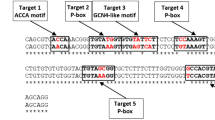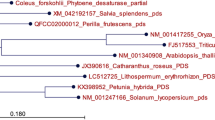Abstract
The expression of maize (Zea mays) phosphoenolpyruvate carboxylase (PEPC) gene constructs in transgenic tobacco plants (Nicotiana tabacum) was studied. Where transcription was under the control of a CaMV 35S promoter, maize PEPC transcripts of the correct size were detected. Western blot analysis indicated that the transgenic plants contained about twice as much PEPC as non-transformed plants. Furthermore, the enzymatic activity of PEPC in the leaves of these transgenic plants was up to twice as high as that in non-transformed plants. Two forms of PEPC with different kinetic properties were identified in leaf extracts of the transgenic plants: one form (the maize isoform) gave a high apparentK m value for phosphoenolpyruvate (PEP) and a high maximum activity, and the other (the tobacco isoform) exhibited a low apparentK m value for PEP and a low maximum activity. These biochemical differences resulted in several significant physiological changes in the transgenic plants: (1) the growth rate of the transgenic plants was lower than that of non-transgenic plants: (2) chlorophyll content per leaf area was relatively lower in the transgenic plants; and (3) the quantum yield of photosynthesis in the transgenic plants was not affected by changes in leaf temperature.
Similar content being viewed by others
References
Arnon, D.I. (1949) copper enzymes in isolated chloroplasts. Polyphenoloxidase inBeta vulgaris.Pl. Physiol. 24, 1–15.
Bevan, M., Barnes, W.M. and Chilton, M. (1983) Structure and transcription of nopaline synthase gene region of T-DNA.Nucl. Acids Res. 1, 369–85.
Bevan, M. (1984) BinaryAgrobacterium vectors for plant transformation.Nucl. Acids Res. 12, 8711–21.
Bradford, M.M. (1976) A rapid and sensitive method for quantitation of microgram quantities of protein utilizing the principle of protein-dye binding.Anal. Biochem. 72, 248–54.
Castresana, C., Staneloni, R., Malik, V.S. and Cashmore, A.R. (1987) Molecular characterization of two clusters of genes encoding the type 1 Cab polypeptides of PSII inNicotiana plumbaginifolia.Pl. Mol. Biol. 10, 117–26.
Christeller, J.T., Laing, W.A. and Sutton, W.D. (1977) Carbon dioxide fixation by lupin root nodules. I. Characterization, association with phosphoenopyruvate carboxylase, and correlation with nitrogen fixation during nodule development.Pl. Physiol. 60, 47–50.
Cretin, C., Santi, S., Keryer, E., Lepiniec, L., Tagu, D., Vidal, J. and Gadal, P. (1991) The phosphoenolpyruvate carboxylase gene family of sorghum-promoter structures, amino acid sequences, and expression of genes.Gene 99, 87–94.
Doncaster, H.D. and Leegood, R.C. (1987) Regulation of phosphoenolpyruvate carboxylase activity in maize leaves.Pl. Physiol. 84, 82–7.
Ehleringer, J. and Björkman, O. (1977) Quantum yields for CO2 uptake in C3 and C4 plants.Pl. Physiol. 59, 86–90.
Hatch, M.D. (1992) C4 photosynthesis: an unlikely process full of surprises.Pl. Cell Physiol. 33, 333–42.
Hayakawa, S., Matsunaga, K. and Sugiyama, T. (1981) Light induction of phosphoenolpyruvate carboxylase in etiolated maize leaf tissue.Pl. Physiol. 67, 133–8.
Hudspeth, R.L., Grula, J.W., Dai, Z., Edwards, G.E. and Ku, M.S.B. (1992) Expression of maize phosphoenolpyruvate carboxylase in transgenic tobacco.Pl. Physiol. 98, 458–64.
Israel, D.W. and Jackson, W.A. (1982) Ion balance, uptake, and transport processes in N2-fixing and nitrate- and urea-dependent soybean plants.Pl. Physiol. 69, 171–8.
Izui, K., Ishijima, S., Yamaguchi, Y., Katagiri, F., Murata, T., Shigesada, K., Sugiyama, T. and Katsuki, H. (1986) Cloning and sequence analysis of cDNA encoding active phosphoenolpyruvate carboxylase of C4-pathway from maize.Nucl. Acids Res. 14, 1615–28.
Jefferson, R.A., Kavanagh, T.A. and Bevan, M. (1987) GUS fusions: β-glucuronidase as a sensitive and versatile gene fusion marker in higher plants.EMBO J. 6, 3901–7.
Kanai, R. and Kashiwagi, M. (1975)Panicum milioides, a gramineae plant having Kranz leaf anatomy without C4-photoxynthesis.Pl. Cell Physiol. 16, 669–79.
Kawamura, T., Shigesada, K., Yanagisawa, S. and Izui, K. (1990) Phosphoenolpyruvate carboxylase prevalent in maize roots: Isolation of a cDNA clone and its use for analyses of the gene and gene expression.J. Biochem. 107, 165–8.
Kawamura, T., Shigesada, K., Toh, H., Okumura, S., Yanagisawa, S. and Izui, K. (1992) Molecular evolution of phosphoenalpyruvate carboxylase for C4 photosynthesis in maize: Comparison of its cDNA sequence with a newly isolated cDNA encoding an isozyme involved in the anaplerotic function.J. Biochem. 112, 147–54.
Kimball, B.A. (1983) Carbon dioxide and agricultural yield: an assemblate and analysis of 430 prior observation.Agronomy J. 75, 779–88.
Krenzer, E.G., Moss, D.N. and Crookston, R.K. (1975) Carbon dioxide compensation points of flowering plants.Pl. Physiol. 56, 194–206.
Ku, M.S.B. and Edwards, G.E. (1977) Oxygen inhibition of photosynthesis. I. Temperature dependence and relation to O2/CO2 solubility ratio.Pl. Physiol. 59, 986–90.
Laemmli, U.K. (1970) Cleavage of structural proteins during the assembly of the head of bacteriophage T4.Nature 227, 680–85.
Maniatis, T., Fritsch, E.F. and Sambrook, J. (1982)Molecular Cloning, A Laboratory Manual, Cold Spring Harbor, New York: Cold Spring Harbor Laboratory Press.
Matsuoka, M. and Minami, E. (1989) Complete structure of the gene for phosphoenolpyruvate carboxylase from maize.Eur. J. Biochem. 181, 593–8.
Moore, P.D. (1982) Evolution of photosynthetic pathways in flowering plants.Nature 295, 647–8.
Murray, H.G. and Thompson, W.F. (1980) Rapid isolation of high molecular weight DNA.Nucl. Acids Res. 8, 4321–5.
Murashige, T. and Skoog, F. (1962) A revised medium for rapid growth and bioassay with tobacco tissue cultures.Physiol. Plant. 15, 473–96.
Nakamoto, H., Ku, M.S.B. and Edwards, G.E. (1983) Photosynthetic characteristics of C3−C4 intermediateFlaveria species II. Kinetic properties of phosophoenolpyruvate carboxylase from C3, C4 and C3−C4 intermediate species.Pl. Cell Physiol. 24, 1387–93.
Nelson, T. and Langdale, J.A. (1989) Patterns of leaf development in C4 plants.Pl. Cell 1, 3–13.
Odell, J.T., Nagy, F. and Chua, N.-H., (1985) Identification of DNA sequences require for activity of the cauliflower mosaic virus 35S promoter.Nature 313, 810–2.
Osmond, C.B., Björkman, O. and Anderson, D.J. (1980) Physiological Processes in Plant Ecology, pp. 66–110. New York: Springer-Verlag.
Plumley, F.G. and Schmidt, G.W. (1989) Nitrogen-dependent regulation of photosynthetic gene expression.Proc. Natl Acad. Sci. USA 86, 2678–82.
Quebedeaux, B. and Chollet, R. (1977) Comparative growth analyses ofPanicum species with differing rates of photorespiration.Pl. Physiol. 59, 42–4.
Rosendahl, L., Vance, C.P. and Pedersen, W.B. (1990) Products of dark CO2 fixation in pea root nodules support bacteroid metabolism.Pl. Physiol. 93, 12–9.
Sakoda, M. and Hiromi, K. (1976) Determination of the best-fit values of kinetic parameters of the Michaelis-Menten equation by the method of least squares with the Taylor expansion.J. Biochem. 80, 547–55.
Sugiharto, B. and Sugiyama, T. (1992) Effects of nitrate and ammonium on gene expression of phosphoenolpyruvate carboxylase and nitrogen metabolism in maize leaf tissue during recovery from nitrogen stress.Pl. Physiol. 98, 1403–8.
Terada, K., Kai, T., Okuno, S., Fujisawa, H. and Izui, K. (1990) Maize leaf phosphoenolpyruvate carboxylase: Phosphorylation of Ser15 with a mammalian cyclic AMP-dependent protein kinase diminishes sensitivity to inhibition by malate.FEBS Lett. 259, 241–4.
Ting, I.P. and Osmond, C.B. (1973a) Multiple forms of plant phosphoenolpyruvate carboxylase associated with different metabolic pathways.Pl. Physiol. 51, 448–53.
Ting, I.P. and Osmond, C.B. (1973b) Photosynthetic phosphoenolpyruvate carboxylase: Characteristics of alloenzymes from leaves of C3 and C4 plants.Pl. Physiol. 51 439–47.
Utter, M.F. and Kolenbrander, H.M. (1972) Formation of oxaloacetate by CO2 fixation on phosphoenolpyruvate. In Boyer P.D. ed.,The Enzymes 3rd ed., vol. 6. pp. 117–68. New York: Academic Press.
Wedding, R.T., Black, M.K. and Meyer, C.R. (1989) Activation of higher plant phosphoenolpyruvate carboxylase by glucose-6-phosphate.Pl. Physiol. 90, 648–52.
Yanagisawa, S. and Izui, K. (1990) Production of active phosphoenolpyruvate carboxylase ofZea mays inEscherichia coli encoded by a full-length cDNA.Agric. Biol. Chem. 54, 241–3.
Yanagisawa, S., Izui, K., Yamaguchi, Y., Shigesada, K. and Katsuki, H. (1988) Further analysis of cDNA clones for maize phosphoenolpyruvate carboxylase involved in C4 photosynthesis.FEBS Lett. 229, 107–10.
Author information
Authors and Affiliations
Rights and permissions
About this article
Cite this article
Kogami, H., Shono, M., Koike, T. et al. Molecular and physiological evaluation of transgenic tobacco plants expressing a maize phosphoenolpyruvate carboxylase gene under the control of the cauliflower mosaic virus 35S promoter. Transgenic Research 3, 287–296 (1994). https://doi.org/10.1007/BF01973588
Received:
Revised:
Accepted:
Issue Date:
DOI: https://doi.org/10.1007/BF01973588




